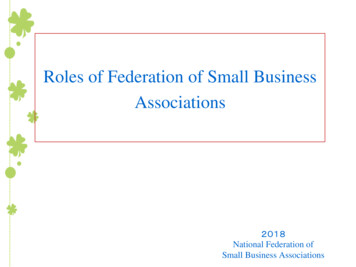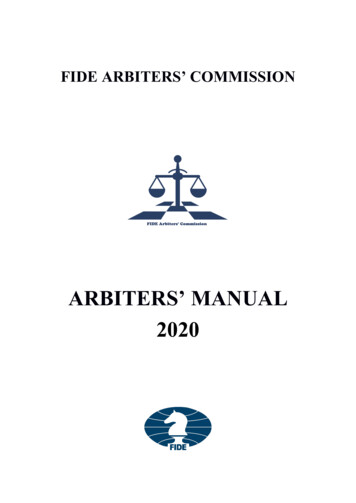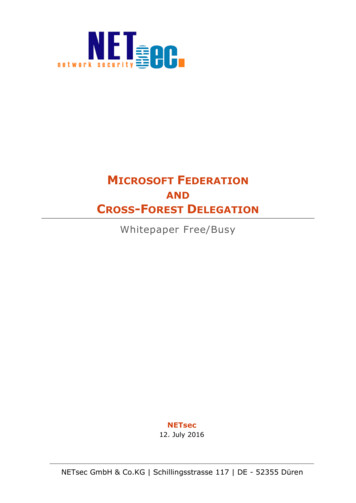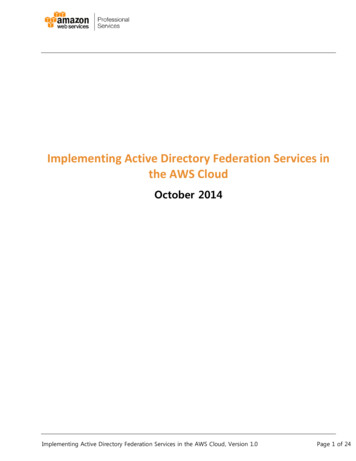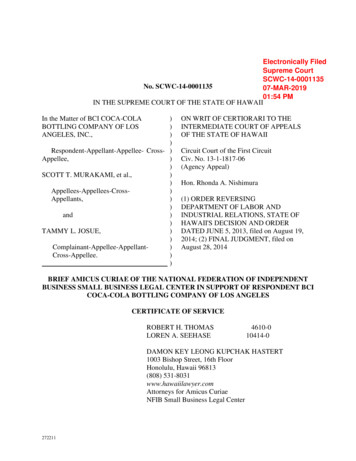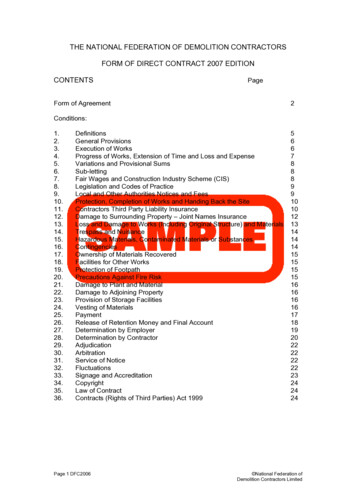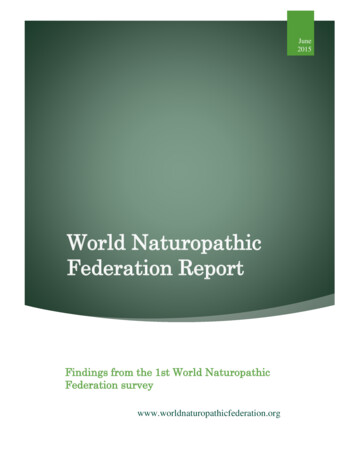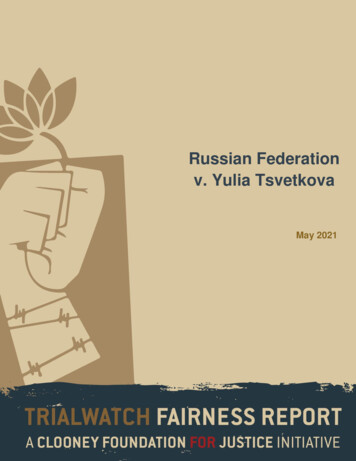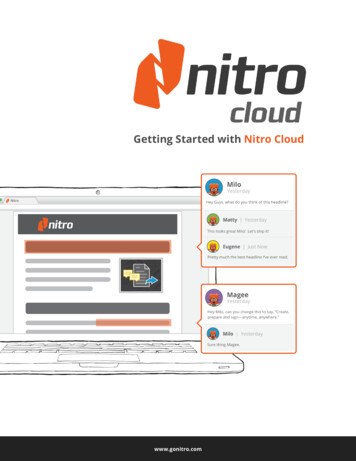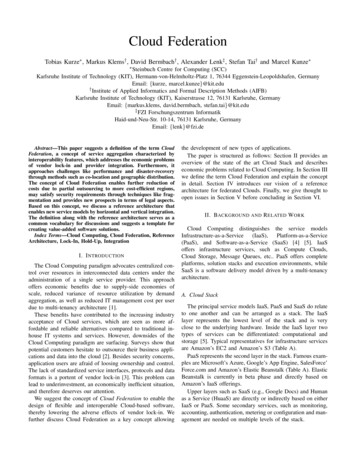
Transcription
Cloud FederationTobias Kurze , Markus Klems† , David Bermbach† , Alexander Lenk‡ , Stefan Tai† and Marcel Kunze SteinbuchCentre for Computing (SCC)Karlsruhe Institute of Technology (KIT), Hermann-von-Helmholtz-Platz 1, 76344 Eggenstein-Leopoldshafen, GermanyEmail: {kurze, marcel.kunze}@kit.edu† Institute of Applied Informatics and Formal Description Methods (AIFB)Karlsruhe Institute of Technology (KIT), Kaiserstrasse 12, 76131 Karlsruhe, GermanyEmail: {markus.klems, david.bermbach, stefan.tai}@kit.edu‡ FZI Forschungszentrum InformatikHaid-und-Neu-Str. 10-14, 76131 Karlsruhe, GermanyEmail: {lenk}@fzi.deAbstract—This paper suggests a definition of the term CloudFederation, a concept of service aggregation characterized byinteroperability features, which addresses the economic problemsof vendor lock-in and provider integration. Furthermore, itapproaches challenges like performance and disaster-recoverythrough methods such as co-location and geographic distribution.The concept of Cloud Federation enables further reduction ofcosts due to partial outsourcing to more cost-efficient regions,may satisfy security requirements through techniques like fragmentation and provides new prospects in terms of legal aspects.Based on this concept, we discuss a reference architecture thatenables new service models by horizontal and vertical integration.The definition along with the reference architecture serves as acommon vocabulary for discussions and suggests a template forcreating value-added software solutions.Index Terms—Cloud Computing, Cloud Federation, ReferenceArchitecture, Lock-In, Hold-Up, IntegrationI. I NTRODUCTIONThe Cloud Computing paradigm advocates centralized control over resources in interconnected data centers under theadministration of a single service provider. This approachoffers economic benefits due to supply-side economies ofscale, reduced variance of resource utilization by demandaggregation, as well as reduced IT management cost per userdue to multi-tenancy architecture [1].These benefits have contributed to the increasing industryacceptance of Cloud services, which are seen as more affordable and reliable alternatives compared to traditional inhouse IT systems and services. However, downsides of theCloud Computing paradigm are surfacing. Surveys show thatpotential customers hesitate to outsource their business applications and data into the cloud [2]. Besides security concerns,application users are afraid of loosing ownership and control.The lack of standardized service interfaces, protocols and dataformats is a portent of vendor lock-in [3]. This problem canlead to underinvestment, an economically inefficient situation,and therefore deserves our attention.We suggest the concept of Cloud Federation to enable thedesign of flexible and interoperable Cloud-based software,thereby lowering the adverse effects of vendor lock-in. Wefurther discuss Cloud Federation as a key concept allowingthe development of new types of applications.The paper is structured as follows: Section II provides anoverview of the state of the art Cloud Stack and describeseconomic problems related to Cloud Computing. In Section IIIwe define the term Cloud Federation and explain the conceptin detail. Section IV introduces our vision of a referencearchitecture for federated Clouds. Finally, we give thought toopen issues in Section V before concluding in Section VI.II. BACKGROUND AND R ELATED W ORKCloud Computing distinguishes the service s-a-Service(PaaS), and Software-as-a-Service (SaaS) [4] [5]. IaaSoffers infrastructure services, such as Compute Clouds,Cloud Storage, Message Queues, etc. PaaS offers completeplatforms, solution stacks and execution environments, whileSaaS is a software delivery model driven by a multi-tenancyarchitecture.A. Cloud StackThe principal service models IaaS, PaaS and SaaS do relateto one another and can be arranged as a stack. The IaaSlayer represents the lowest level of the stack and is veryclose to the underlying hardware. Inside the IaaS layer twotypes of services can be differentiated: computational andstorage [5]. Typical representatives for infrastructure servicesare Amazon’s EC2 and Amazon’s S3 (Table A).PaaS represents the second layer in the stack. Famous examples are Microsoft’s Azure, Google’s App Engine, SalesForce’Force.com and Amazon’s Elastic Beanstalk (Table A). ElasticBeanstalk is currently in beta phase and directly based onAmazon’s IaaS offerings.Upper layers such as SaaS (e.g., Google Docs) and Humanas a Service (HuaaS) are directly or indirectly based on eitherIaaS or PaaS. Some secondary services, such as monitoring,accounting, authentication, metering or configuration and management are needed on multiple levels of the stack.
B. Cloud Software and Cloud Products1) Private Cloud Computing Software: There is a broadspectrum of open source software, which mimics the proprietary systems of Amazon, Google, & Co. For example,Eucalyptus, AppScale, typhoonAE, and OpenNebula (TableA). Users can install the open source software “in-house” asprivate cloud solutions. Since such a private cloud solution ispartially compatible with the interfaces, protocols, programming models, and deployment options of the proprietary publicclouds, this might be an approach to create an interoperablehybrid cloud, a composition of private and public clouds [6].2) Cloud Marketplaces and Federation Offerings: Whilemarketplaces, like Zimory or SpotCloud allow trading withCloud resources, offerings like CloudKick and ScaleUp provide some federation functionality, e.g., monitoring and management supporting multiple clouds (Table A).C. Economic Theory1) Vendor Lock-in: Vendor lock-in has been studied in economics research communities, for example by Robin Cowan[7]. Cowan identifies two sources of vendor lock-in: uncertainty of selecting an unknown technology, and the learningcurve of a technology. The problem with two technologies Aand B is formalized as the dynamic programming problem“Two-armed bandit”.We observe a growing number of Cloud Computing serviceproviders and service offerings, in particular Cloud Storageand Compute services. These offerings tie users to a specifictechnology, which cannot be switched or replaced withoutsignificant switching cost. Apparently, this is the case forPaaS offerings, e.g., Google App Engine, which are closelyintegrated with proprietary services, such as Google user accounts and the Google e-mail service. Offerings like AmazonWeb Services seem to have lower switching costs becausethey build upon Web service standards. However, a competingservice provider would have to provide a similar technology(distributed system) with similar quality levels (availability,reliability, latency, throughput, etc.) and features (launch, stop,start, etc.).This leads to the consequence, that users depend on thebusiness strategy of the service provider.2) Hold-up Problem and Underinvestment: The hold-upproblem has been described by Klein, Crawford and Alchian[8] as being basically a contract problem. Two firms want tostart business relations. In order to do so one party has tomake an investment, which is specific in regard to the otherparty. Transferred to a concrete Cloud scenario a companycould invest in developers and applications which are usingAmazon’s Web Services. This particular investment is ofvirtually no use when not used in the context of the twoparties, i.e., the applications can not be used with Google’sApp Engine for example nor can the spezialized developerswork with Microsoft’s Azure. It is not possible to writecomplete contracts, i.e., contracts containing all, even futureaspects of business relations, which might have an influenceon the returns from the investment. [9] Due to incompletecontracts it is very likely that situations will arise that havenot been foreseen at the time of the contract writing, makingrenegotiations necessary. In such future interactions one partymay take advantage of the lock-in situation.A party, anticipating the risk of a lock-in situation, typicallytakes suboptimal investment decisions, leading to underinvestment. [10, 11] When already facing the lock-in problem,a company may decide to stop further investment or toexpend resources to protect itself against the lock-in. A partyanticipating lock-in, hence, ends up in a hold-up situation,which in either case, leads to inefficient results. [9]Ewerhart et al. [12] summarized that in a lock-in situation,market forces are no longer effective and there is a risk of expost opportunistic behaviour. A party being forced to acceptsub-optimal conditions cannot escape the situation due to thelock-in and finds itself in a hold-up [13].III. C LOUD F EDERATIONCloud federation comprises services from differentproviders aggregated in a single pool supporting threebasic interoperability features - resource migration, resourceredundancy and combination of complementary resourcesresp. services. Migration allows the relocation of resources,such as virtual machine images, data items, source code,etc. from one service domain to another domain. Whileredundancy allows concurrent usage of similar servicefeatures in different domains, combination of complementaryresources and services allows combining different types toaggregated services. Service disaggregation is closely linkedto Cloud Federation as federation eases and advocates themodularization of services in order to provide a more efficientand flexible overall system.We identify two basic dimensions of Cloud Federation: horizontal, and vertical. While horizontal federation takes placeon one level of the Cloud Stack e.g., the application stack,vertical federation spans multiple levels. In the following wefocus on horizontal federation; aspects of vertical federationare out of the scope of this publication.Several aspects of horizontal federation can be distinguished, e.g., provider domain and geography. Horizontalfederation across provider domains may decrease providerdependency and thereby lower the risks of vendor lock-inand hold-up. Increased availability may be achieved throughhorizontal federation across multiple geographic regions. Also,vertical federation scenarios along similar aspects are imaginable.Cloud Federation can be of interest for providers as wellas for customers. Customers may profit from lower costs andbetter performance, while providers may offer more sophisticated services. However, hereinafter we focus on the customerperspective.Two types of scenarios can be linked to Horizontal Federation: Redundancy: is used whenever there is a subset of (properly organized) service offerings that provide better util-
ity to aSclient than any single service offering xi , i.e., X i xi where xi : u(X) xi . the duration is,at least regarding a near time horizon, permanent as theuser purposefully uses multiple service providers at thesame time.could be security considerations where each provider onlyknows a tiny subset of the data. In the 2nd case, tasksare spread to the best fitting VMs to optimize latency andthroughput. Migration: can be triggered when a new service offeringoffers better utility to a client than any previously usedservice offering, i.e., xnew xi : u(xnew ) u(xi ) u(cS s)where cs are the total switching costs and xnew 6 i xi .Figure 2 illustrates the behavior over time of the twoscenarios. Replication: Data items are distributed as a whole andmultiple copies are stored to increase availability whileremoving a single point of failure [15, 16, 17, 3] and reducing vendor lock-in. Furthermore, an increased numberof replica may improve read latency due to customer proximity and increases durability. This is especially of interestwhen addressing resilience to correlated failures. However,whenever copies of the same data are kept at differentsites there is a general tradeoff between consistency andavailability as well as latency depending on how a storagesystem updates replica. This may happen synchronously,asynchronously in the background or as a combination ofboth.Fig. 1.Migration vs. Redundancyb) Storage Services: know 3 kinds of redundancy: Erasure coding: Erasure coding uses RAID-like algorithms[18, 19] to distribute parts of data. If those parts overlap itis possible to restore data items even if a limited numberof parts is missing. This obviously improves security aseach provider knows only a tiny subset of the data item. Fragmentation: Here, items of type 1 are stored at providerA while type 2 is stored at provider B. This is useful whenfunctional (e.g., data structure) and non-functional requirements (e.g., geographic location, durability, consistency)differ for different types of data.A. RedundancyFollowing the technical Cloud Stack [5] we can distinguishIaaS, PaaS and SaaS as different levels where horizontalredundancy can be used.1) IaaS:a) Compute services: know 3 kinds of redundancy: Redundant deployment: The same application logic isdeployed to different providers. Still, incoming requests areprocessed by only one instance. Redundant deployment isused to increase the availability while decreasing providerdependence. Other reasons to do so could be compliancewith regulations, which require instances in particulargeographic locations. Also, customer proximity could bean issue to reduce latency. Redundant computation: The same application logic isdeployed to different providers. Nevertheless, in contrast toredundant deployment here every request is processed bymore than one instance. Reasons to do so could be either toimprove performance by reducing the risk of an instancefailing right before completing a task, an approach e.g.,taken in Google’s MapReduce [14], or limited trust in theprovider returning correct results. Parallel computation: Here, the data is broken down at bitlevel and processed at different providers’ sites followingthe same application logic or complimentary services aredeployed to different providers. Reasons for the 1st case2) PaaS:PaaS offerings are hard to use redundantly as they usuallynot only follow a different programming model and supportonly a limited number of programming languages but alsodo applications developed for a particular PaaS offering makeuse of an entire ecosystem of services provided just withinthat PaaS offering. Furthermore, PaaS generally introduceslimitations on the programming model they build upon so thatapplications need to be fine-tuned for a particular platform. So,the only sensitive alternative when trying to use federated PaaSofferings is to use one for which an open source offering exists,which can, hence, be hosted by the customer or on top of IaaScompute resources. An example would be to redundantly useGoogle App Engine and AppScale running on top of AmazonEC2.3) SaaS: Multiple SaaS offerings can be used redundantlywith focus on different aspects: Focus on user experience: In this case software serviceswith similar functionality are used concurrently. An application could e.g., allow the end user to toggle betweenvisualization using Google or Bing Maps. This couldenhance user experience by enabling a user to use a servicehe is used to. As a side effect, it would increase availability. Focus on availability: In this case software services withsimilar functionality are required but not used concurrently.An application might switch over to a backup service in
case of unavailability of the primary service.While fine-grained SaaS offerings, e.g. Map services, canbe used in a federation context relatively easy, it is veryhard and probably cost-intensive to federate more complexservices like e.g. Salesforce. The difficulty to federate suchofferings is caused by the fact, that it is virtually impossible toisolate smaller building blocks of the service as no competingsolutions exist, which offer exactly the same functionality.Also, the potentially proprietary data formats and APIs ofsuch services increase the problem. We believe that the issuesrelated to the federation of SaaS offerings with larger granularity cannot be addressed in an adequate way by technicalapproaches and are therefore beyond the scope of this paper.B. MigrationMigration incorporates scenarios where data respectivelyresources are being transferred from one Cloud provider A toanother Cloud provider B. We identify two types of migration: Shadowed or redundant migration: In a migration scenariomultiple similar services are usually only used for a limitedamount of time during which the old service is stilloperational while the new service is introduced. In thebeginning, the new service is shadowing the old service totest it with live data. After switching over, the old serviceis shadowing the new one as a fallback solution in case ofunanticipated failures. Finally, the old service is put out ofservice and the migration is finished. Non-redundant migration: Here, there is a hard switchover. There is no shadowing period before or after.In addition to those two types we distinguish between fulland partial migration: In the case of full migration an entire service stackis migrated, i.e., all components belonging to a certainservice are migrated e.g., a web server along with itsdatabase. Partial migration is linked to service disaggregation anddescribes the migration of service components or modules.A service composed of multiple components can be disaggregated into sub-services, some of which may then bemigrated, before being reestablished as separate service.IV. T OWARDS A R EFERENCE A RCHITECTURECloud services offer access to services, which are associated with pools of stateful resources, e.g., virtual machines,data storage, queues, e-mail systems, etc. Our concept of aresource is similar to the notion of resources within the WSResource framework [20], however, less formalized becausecloud services do not necessarily standardize on Web Servicespecifications.We distinguish between two types of programmatic accessto these resources: Resource API Management APIApplications implement the Resource API to access andutilize resources, which are exposed as business logic. Forexample, Amazon S3 offers a Resource API to create, read,update, and delete basic storage volumes (“buckets”) andupload or download data objects. Within the business logic ofa photo-sharing application, buckets could be used as photoalbums and a data object within a bucket would representa photo image file. Table I illustrates that a photo-sharingapplication could be implemented with Cloud services fromeither Amazon or Google - or with a mix of services fromboth providers.TABLE IE XAMPLE PHOTO - SHARING APPLICATION .Application featureAWSGoogle App EnginePhoto storagePhoto notificationImage editingPhoto sharingS3 buckets & obj.SQS or SNSN/ASESData store or BlobstoreChannel serviceImage serviceMail serviceThe Management API helps application developers andadministrators to manage resources efficiently. This includesa variety of activities: monitoring, deployment, data management, and so on. For example, Amazon EC2 offers aManagement API for managing virtual machines (e.g., launch,stop, terminate) along with related settings and add-on services (e.g., security groups, block storage volumes, static IPaddresses). Google App Engine offers a Management APIto deploy application packages into the runtime environmentand a dashboard for monitoring and administration (e.g., logs,cron jobs, datastore indexes, application versions and releasemanagement).A. Two Perspectives on InteroperabilityInteroperability challenges can be viewed from the perspective of a service provider or from the perspective ofa service user. A service provider could be interested inoffering distributed system services, which are interoperablewith established, proprietary de-facto standards. Service users,on the other side, could design and implement applicationswith adaptors to multiple service providers, thereby enablingfederation.Table II shows 5 open source systems, which offer servicessimilar to Amazon EC2 and Amazon S3. These systemssupport the interface definitions and protocols of their AmazonWeb Services counterparts. Currently, all of the open sourcesystems offer merely a small subset of comparable servicesand therefore only cover a subset of the Amazon Web ServicesAPI. The quality of a hosted open source solution, however,significantly depends on the system management skills of thehosting provider with regard to system scalability, performanceand fault-tolerance. The systems could for example be backedwith open source distributed system solutions, such as ApacheHBase or Apache Cassandra, thereby providing a basis forachieving higher quality levels. Still, this induces even moreintegration challenges.Table III shows a list of multi-cloud libraries, which enableinteroperability across similar cloud services on a higher level
TABLE IIA MAZON W EB S ERVICES (AWS) COMPATIBLE OPEN SOURCE C LOUDMANAGEMENT SYSTEMS .NameAPIAWS-compatible OCCI, AWSCloudStack, AWSOpenStack, AWSNimbusWSRF, AWSEucalyptus (EC2), Walrus (S3)OpenNebula (EC2)CloudStack CloudBridge (EC2)OpenStack: Compute, Image Service (EC2) & Object Storage (S3)Nimbus (EC2), Cumulus (S3)TABLE IIIC OMPARISON OF MULTI - CLOUD LIBRARIES AND UTILITY PROGRAMS .AWSa RAXb GOOGc VMWd MSe GGfNameLang.LicensejcloudsJetS3tJavaJavaApache2 yesApache2 yesyesnoyesyesyesnoyes yesno usPython Apache2 yesnononononoyesyesyesyesyesPyStratus can be used to deploy complex distributed systemson top of exchangeable compute clouds, such as EC2 or theRackspace Cloud.Both strategies, interoperable open source solutions andmulti-cloud application code, can be employed to facilitatetransparent application migration. Redundancy is more complicated to establish: Either it is explicitly foreseen in theapplication’s code or there is a federation system providing asuitable programming abstraction. An additional layer decouples the application from the actual resources and permits theirtransparent reconfiguration, e.g., change redundancy strategyto erasure coding. Figure 3 illustrates the two strategies.Fig. 3.Redundancy Strategiesa Amazon b Rackspace c Google d VMWare e Microsoft f GoGridthan the systems discussed before. During the implementationof an application, the libraries jclouds, JetS3t, fog, boto,libcloud, and deltacloud are linked into the build path. Whenthe application has been implemented, it can be deployed usingany of the library-supported cloud services. This simplifiesmigration processes and redundancy setups as described in thesections before as there is no need to re-design the application.Instead, simple configuration options, usually just the serviceendpoints, must be changed. Figure 2 illustrates the migrationof a service and the impacts on the service endpoints and thethereon based application.Fig. 2.Migration scenario illustrating impact on service endpointsAdditionally, utilities like Whirr (based on jclouds) andB. Potential Reference Architecture ComponentsThe open source cloud management systems in table IIand the multi-cloud software libraries in table III are crucialelements for creating a federated cloud application. However,the systems and libraries should be discussed in a widercontext to answer how applications can be migrated from onecloud service to another or operated on top of redundant cloudservices.We suggest that a reference architecture should contain thefollowing components: Provisioning Engine: takes an application package alongwith policies and maps business logic components toa pool of resources. The projected mapping along withmanagement configurations is then executed and enforcedthrough a Distribution Manager. DistributionManager: contains multiple subcomponents through which it enforces guaranteesspecified with policies. For example, enforce consistencybetween data replica; enforce the same deploymentconfiguration on multiple servers. It may also serve as aredundancy decoupling layer. Principal components are:– Deployment Manager: is a component of the Distribution Manager. Based on a deployment descriptionthe manager executes resource management commands through Resource Managers. It guarantees theavalabillity and the correct configuration of provisioned resources.– Configuration Manager: is a component of theDeployment Manager. It recreates virtual appliancesresp. application stacks based on stored configurationinformations.
– Data Distribution Manager: is a component of theDistribution Manager. It manages the distribution ofdata, e.g., data replication, data redundancy, according to the distribution strategies.The distribution managers secondary components are:– Transformation: is used to transform incompatibleformats, e.g., virtual machine images and to mapbetween different data formats.– Monitoring: gathers information about resourcestates and information about their configurationthrough the Resource Managers. In case of unexpected conditions the Distribution Manager adaptsthe system to match the projected provision mapping. Resource Manager: manages all resources in a unifiedway. It can be realized as a collection of resourcelocalized components. The Resource Manager providesan abstraction of the APIs of the underlaying services andallows the Distribution Manager to configure resources indifferent clouds in a unified way. It may use adaptors, forexample multi-cloud libraries, to perform its tasks.Figure 4 depicts our current vision of the reference architecture. We have to point out, that we are still doing researchon the reference architecture and that the figure should onlybe considered a snapshot of our momentary work in progress.Fig. 4.Reference Architecturebe necessary, thus exceeding the benefits of the providerchange. This implicates, that in Cloud Computing, lock-in- and in consequence hold-up, is a result of the different,proprietary interfaces, services and service offerings and thecomplexity involved in coping with this issues.Since Cloud Federation resolves the above mentioned issuesor - at the least - lowers the costs involved, we claim that itthereby resolves lock-in as well as hold-up and is a key enablerof Cloud marketplaces.B. Future WorkDue to the short character of this article we could notincorporate our thoughts on Vertical and Secondary ServicesFederation. Also the proposed federation reference architecturehas to be elaborated in more detail in future works. Notably wedid not outline details on our vision of application packagesand how the architecture’s components could be realized.VI. C ONCLUSIONCloud Federation is a concept, which has a large potentialand might have an enormous influence on the way computingresources and applications will be handled, developed andused. It is a further step of providing computing resourcesin an utility-services-like way, similar to other services, e.g.,electricity or water. However the evolution of Cloud Computing and related concepts and technologies is extremelydynamic and it is very difficult to make long-term prognoses.We believe anyhow, that this article can be a substantialcontribution to future works on Cloud Federation.ACKNOWLEDGMENTThe work presented in this paper was performed inthe context of the Software-Cluster project EMERGENT(www.software-cluster.org). It was partially funded by theGerman Federal Ministry of Education and Research (BMBF)under grant no. “01IC10S01”. The authors assume responsibility for the content.A PPENDIXTable A - Cloud product overviewNameURIV. D ISCUSSIONA. Vendor Lock-In and Cloud ComputingAs depicted in Section II, vendor lock-in exists whenpotential switching costs surpass the benefits the customerwould enjoy by switching to another provider. This is currentlythe case with Cloud Computing: by switching the providerthe initial ex-ante investments could be largely lost and newinvestments, to adapt the software and retrain employees, willAmazon’s EC2Amazon’s Elastic BeanstalkAmazon’s S3AppScaleCloudKickGoogle App EngineMicrosoft AzureSalesForce’ .com
Table B - Multi-cloud library 0]Table C - Open source cloud management systems .org/http://www.openstack.org/[11]R EFERENCES[12][1] R. Harms and M. Yamartino, “The economicsofthecloud,”PublishedOnline /docs/The-Economics-of-the-Cloud.pdf, Microsoft Corporation,Redmond,WA,USA,Microsoft Whitepaper, November 2010. [Online].Available: /docs/The-Economics-of-the-Cloud.pdf[2] “Microsoft: Smb hosted it commentary report,” 2010.[3] M. Armbrust, A. Fox, R. Griffith, A. D. Joseph,R. Katz, A. Konwinski, G. Lee, D. Patterson, A. Rabkin,I. Stoica, and M. Zaharia, “Above the clouds: Aberkeley view of cloud computing,” University ofCalifornia at Berkeley, Tech. Rep., February 2009.[Online]. Available: louds-released.html[4] P. Mell
further discuss Cloud Federation as a key concept allowing the development of new types of applications. The paper is structured as follows: Section II provides an overview of the state of the art Cloud Stack and describes economic problems related to Cloud Computing. In Section III we define the term

![[MS-ADFSOD]: Active Directory Federation Services (AD FS .](/img/1/5bms-adfsod-5d.jpg)
